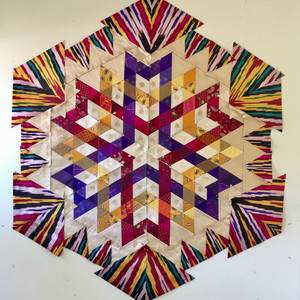Exploring Ikat Textiles
- juliamcleod7
- Nov 3, 2021
- 3 min read
I have loved Ikat fabrics for as long as I can remember. The striated, colorful designs combine symmetry with a painterly feel that my eyes find truly exciting.
The word ‘Ikat’ is the Indonesian word for ‘bind’. When the warp threads of a fabric are tied and dyed in carefully calculated bundles, a design is created before the warp is even on the loom. The figures and patterns emerge as the fabric is woven.
Ikat fabrics exist in cultures as far apart as Indonesia, Africa, India, South America, Central Asia and Japan. Head to Wikipedia for a really exhaustive article on this textile technique.

(Photo credit: @ikatbyfelli www.ikatbyfelli.com)
In one of the first workshops I taught on quilting with silk, participants were invited to bring their silk fabrics to show. So many of us had collected silk fabrics from saris, kimono, cheongsams and neckties. But one student produced a length of shiny, gaudy stuff that got me really intrigued. I had never seen fabric like it. We all hazarded our best guesses as to where it was made - China? India? Mexico? - but it was only after scouring the internet that we learned this fabric was made in Uzbekistan. Read more in this article from Cloth Roads about the fascinating history of Uzbek Ikat textiles. The town of Margilon, in the Fergana Valley, is a textile hub. It’s on my short list of places to go - with an empty suitcase for all those luscious Ikats!
I was overwhelmed when my workshop student handed me the fabulous fabric and said ‘You’ll do something wonderful with it!’. So of course I did what quilters so often do with beautiful fabric: I put it away in a drawer. For two years.

As many of us have discovered, there’s nothing quite like a pandemic to make you turn to your stash. The Uzbek Ikat called my name at the start of this year and I finally took my scissors to it. It’s slippery, satin weave stuff, possibly with some rayon content, and it may even have a cotton weft. Careful handling is required. I used a fabric foundation to add accuracy and stability to my design. The zig zags, points and angles of the design inspired me to fussy cut wedges from the fabric and bring them together to create kaleidoscopic circles. I couldn’t always get 8 wedges that looked the same, which led to combining four pieces of one pattern with four of another.
Gradually nine circles emerged and I had used up just about every last scrap of the fabric.

I set the circles in black dupioni silk, punctuated the design with stars, and sketched some quilting designs for my long-arm quilter inspired by Uzbek embroideries. I love this quilt but it doesn’t feel finished to me. I plan to add a fancy border and binding when time allows me to get back to work on it.
(Quilting by Kathy Ritter at New Pieces, Berkeley CA)
It was while I was piecing this quilt that I ran an errand to the post office and passed a sign advertising an estate sale. Among the pots, pans, linens and furniture I was amazed to find 13 yards of bright, shiny Uzbek Ikat. Talk about serendipity, synchronicity and sheer destiny! I snapped it up for $20. Another ikat quilt was in my future.

Some time ago I made a silk quilt using the Rising Star pattern, a Foundation by the Yard design from Benartex.

I saw potential in this pattern for exploring color transparencies and overlapping motifs. Drawing my color palette from my Ikat fabric, I created this hexagonal center motif.

With more fussy cutting, I’ve added an Ikat border, followed by some strips of black silk. And here’s where I’m at:
It’s a WIP, stalled for the moment by other projects taking priority. I can’t wait to get back to it and spend time again with that shiny, gaudy stuff from the far away Fergana Valley.



















Really enjoyed the article and love your “vision” for challenging fabrics. I have many pieces that have been held way longer than two years.
I've always loved Ikat, too, and I'm glad you shared a bit about how it's made. Very interesting. I had to laugh just a little when you said it sat in a drawer for 2 years. Of course it did! lol But when you did cut into it, it seems you did it with purpose and met with great success. Congratulations! The wedges are a brilliant idea for dealing with a busy, crazy print! Juna
So interesting and informative. Your piece are spectacular.